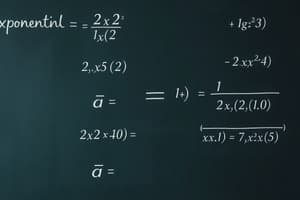Podcast
Questions and Answers
What is the definition of an exponential function?
What is the definition of an exponential function?
- log b of a = log of a/log of b
- f(n) = aⁿ, where a is constant (correct)
- log base of # = exponent
- f(x) = log of x
What is always true about the range of exponential functions?
What is always true about the range of exponential functions?
The range is always positive.
What is the first step in graphing exponential functions?
What is the first step in graphing exponential functions?
- Connect the line
- Make a table by plugging in coordinates for x (correct)
- Plot points
- Flip the table
What is the process to graph logarithmic functions?
What is the process to graph logarithmic functions?
What does 'logarithm' entail regarding negative numbers?
What does 'logarithm' entail regarding negative numbers?
What is the change of base formula?
What is the change of base formula?
What is the parent log graph equation?
What is the parent log graph equation?
What transformation does f(x) = a + log of (x-b) indicate?
What transformation does f(x) = a + log of (x-b) indicate?
Flashcards are hidden until you start studying
Study Notes
Exponential Functions
- Defined as f(n) = aⁿ, where "a" is a constant.
- Range is always positive; approaches zero but never reaches it as the domain decreases.
Graphing Exponential Functions
- Create a table by inputting values for x.
- Plot corresponding points on the graph.
- Connect points to form a smooth curve representing the function.
Graphing Logarithmic Functions
- Determine the inverse of the log function, which is an exponential function.
- Input values for x into a table and calculate corresponding y values.
- Switch the x and y coordinates to invert the table.
- Plot the new points and connect them to visualize the logarithmic function.
Logarithm
- Represents the relationship log base of a number equals the exponent.
- Taking the logarithm of negative numbers is not permissible; the argument must always be positive.
Change of Base Formula
- Provides a method for calculating logarithms with different bases.
- Expressed as log b of a = log of a / log of b.
Parent Log Graph
- The basic log function is defined as f(x) = log of x.
- Serves as the foundational graph for logarithmic transformations.
Logarithmic Transformations
- Generally expressed as f(x) = a + log of (x-b).
- The "a" value determines vertical shifts, moving the graph up by "a" units.
Studying That Suits You
Use AI to generate personalized quizzes and flashcards to suit your learning preferences.




